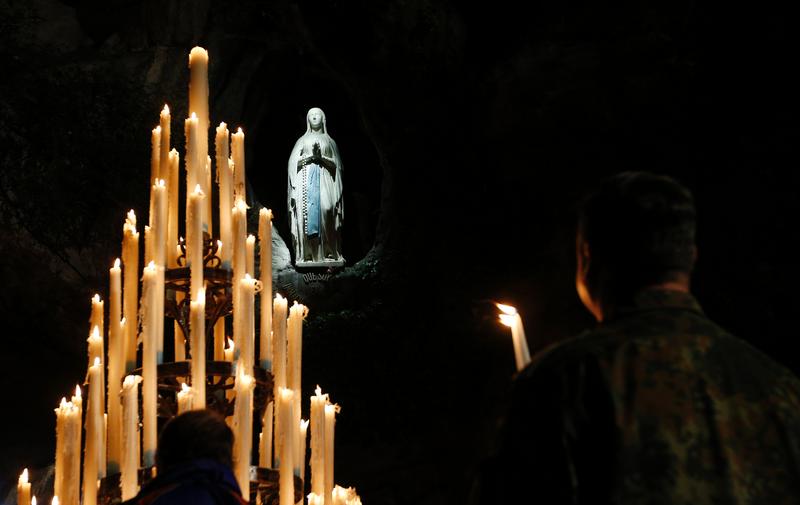Of the Mother of God’s many titles, her appearance in France has led to thousands of healings, including 70 official miracles
DETROIT — On March 15, during the first of many livestreamed Masses at the Cathedral of the Most Blessed Sacrament, Archbishop Allen H. Vigneron pledged to build a grotto to Our Lady of Lourdes as a “perpetual reminder” of her care.
Without the physical presence of the congregation and with tears in his eyes, the archbishop promised to build a shrine “as a lasting token of my gratitude, our gratitude, for the protection of the Blessed Virgin Mary,” particularly during the unprecedented COVID-19 crisis.
On Wednesday, May 6, the archbishop will join the bishops of North America in renewing the archdiocese’s total consecration to the Blessed Mother during a special 7 p.m. rosary.
But the archbishop’s choice to entrust the people of Detroit to Our Lady of Lourdes — out of the Blessed Mother’s many titles — is no accident.
Our Lady of Lourdes first appeared to St. Bernadette Soubirous in 1858, declaring to the young saint, “I am the Immaculate Conception.” The Sanctuary of Our Lady of Lourdes, in southern France, is built on the site of these apparitions, and it is also the site of a spring of water said to have “miraculous healing properties.”

To this day, the sick and ailing still visit the shrine, and more than 7,000 healings have been attributed to miraculous spring, with 70 miracles enjoying official recognition by the Catholic Church.
While for the first time in its history, the sanctuary has been closed as a result of COVID-19, the blessings offered by Our Lady of Lourdes never cease, nor is her intercession less powerful, Archbishop Vigneron told Detroit Catholic.
“I think it’s very appropriate that we put ourselves under the Blessed Mother’s protection,” Archbishop Vigneron said. “Lourdes is the place where Jesus sent her to be a missionary and an evangelist of his closeness to us in our times of trial and sickness. He offers us his grace even in difficulties. I think Lourdes epitomizes that message.”
The archbishop often accompanies the Order of Malta during its annual pilgrimages to Lourdes — he’s been to the shrine approximately eight times, he said.

Each year, the Soveriegn Military Order of Malta, a lay order with more than 900 years of Church history, brings hundreds of malades — which means “sick person” in French — to the healing grottos to ask for Our Lady of Lourdes’ protection and blessing, said Robert Wilson, who along with his wife, Barbara, is the area chair for the Order of Malta in Michigan.
“Our special charisms are taking care of the sick and the poor and defending the Catholic faith,” Wilson said.
The order began caring for pilgrims traveling to and from the Holy Land around the time of the crusades, Wilson said. Along the way, many of the pilgrims became sick or were injured. During the crusades, the “Knights,” as members are called (female members are called “Dames”), took care of both Christians and Muslims wounded in battle. Eventually, they founded the first hospital in the world, Wilson said.
Many have experienced healings at Lourdes — both physical and spiritual, Archbishop Vigneron said.
“During the times I have been to Lourdes as a pilgrim, I have learned and repeated this phrase: ‘At Lourdes, there are a few cures, but there is healing for everyone,’” the archbishop said.
Wilson said the archbishop’s plan to build a grotto is a beautiful declaration of a much deeper relationship with the Mother of Christ — a relationship that extends further with the archdiocese’s special patroness, Ste. Anne, who is Mary’s own mother.

“The women in the Church have been a powerful force,” Wilson said. “We can’t get enough of Ste. Anne or the Blessed Mother, and we can’t get enough intercession for this city. This city has gone through very difficult times.”
Archbishop Vigneron said he isn’t sure when the shrine will be built, but he is sure that it will happen.
“It’s a plan, and it’s a way to thank God ahead of time for what we know He will do through the prayers of the Blessed Mother,” Archbishop Vigneron said. “We are going to do this as a way to remember how good God has been to us through this time of the crisis.”











